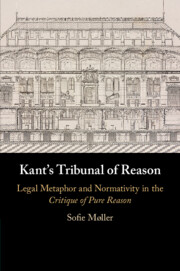Book contents
- Kant’s Tribunal of Reason
- Kant’s Tribunal of Reason
- Copyright page
- Dedication
- Contents
- Acknowledgements
- Abbreviations
- Introduction
- Chapter 1 The Critique of Pure Reason as the Establishment of Reason’s Lawful Condition
- Chapter 2 The Normativity of Law
- Chapter 3 The Transcendental Deduction of the Categories and the Tradition of Legal Deductions
- Chapter 4 The Question of Fact and the Question of Law in Judicial Imputation and in the Transcendental Deduction of the Categories
- Chapter 5 The Tribunal of Reason
- Chapter 6 Moral Conscience as the Practical Inner Tribunal
- Chapter 7 Distinguishing between Rightful Claims and Groundless Pretensions
- Chapter 8 Epistemic Authority as both Individual and Collectively Shared
- Chapter 9 Systematicity and Philosophy as the Legislation of Reason
- Conclusion
- Bibliography
- Index
Chapter 5 - The Tribunal of Reason
Published online by Cambridge University Press: 24 February 2020
- Kant’s Tribunal of Reason
- Kant’s Tribunal of Reason
- Copyright page
- Dedication
- Contents
- Acknowledgements
- Abbreviations
- Introduction
- Chapter 1 The Critique of Pure Reason as the Establishment of Reason’s Lawful Condition
- Chapter 2 The Normativity of Law
- Chapter 3 The Transcendental Deduction of the Categories and the Tradition of Legal Deductions
- Chapter 4 The Question of Fact and the Question of Law in Judicial Imputation and in the Transcendental Deduction of the Categories
- Chapter 5 The Tribunal of Reason
- Chapter 6 Moral Conscience as the Practical Inner Tribunal
- Chapter 7 Distinguishing between Rightful Claims and Groundless Pretensions
- Chapter 8 Epistemic Authority as both Individual and Collectively Shared
- Chapter 9 Systematicity and Philosophy as the Legislation of Reason
- Conclusion
- Bibliography
- Index
Summary
This chapter shows that the antinomies of pure reason present an analogy between the critique and a civil trial in which reason in the narrow sense is challenged to prove that it can legitimately possess and use its ideas. In reconstructing the different parts of this image, Møller suggests reading the tribunal image as a second-order model of evaluation of judgements. In order to achieve this aim, Møller inspects the different roles and procedures mentioned in the juridical metaphors to see how they fit the different procedures in the antinomies. The chapter untangles the notions of the tribunal itself, the trial, the witnesses, the audience and the verdict. The image of the reader as judge is considered in its intellectual historical context, which shows an affinity between Kant’s use of this image and the project of enlightenment.
Keywords
- Type
- Chapter
- Information
- Kant's Tribunal of ReasonLegal Metaphor and Normativity in the <I>Critique of Pure Reason</I>, pp. 81 - 95Publisher: Cambridge University PressPrint publication year: 2020

